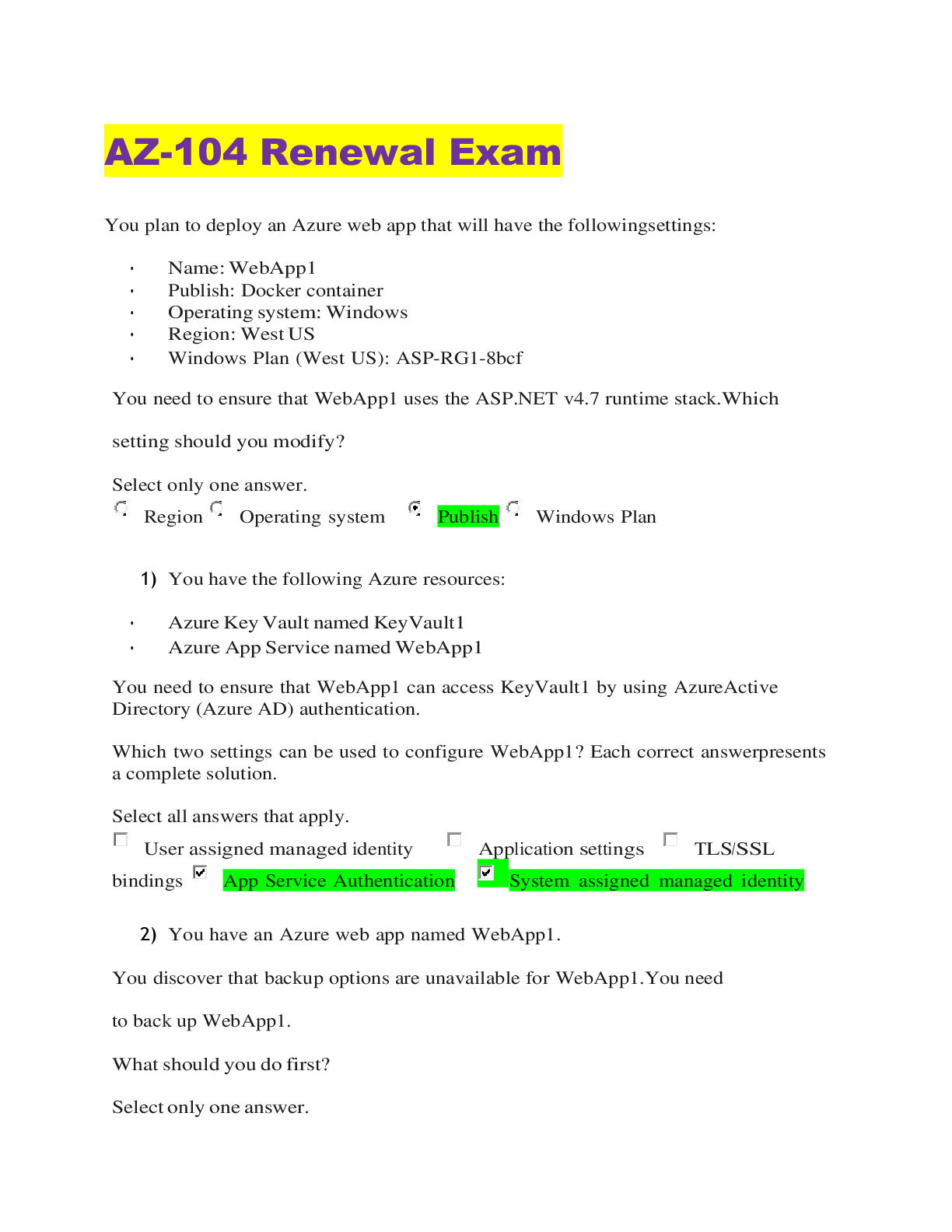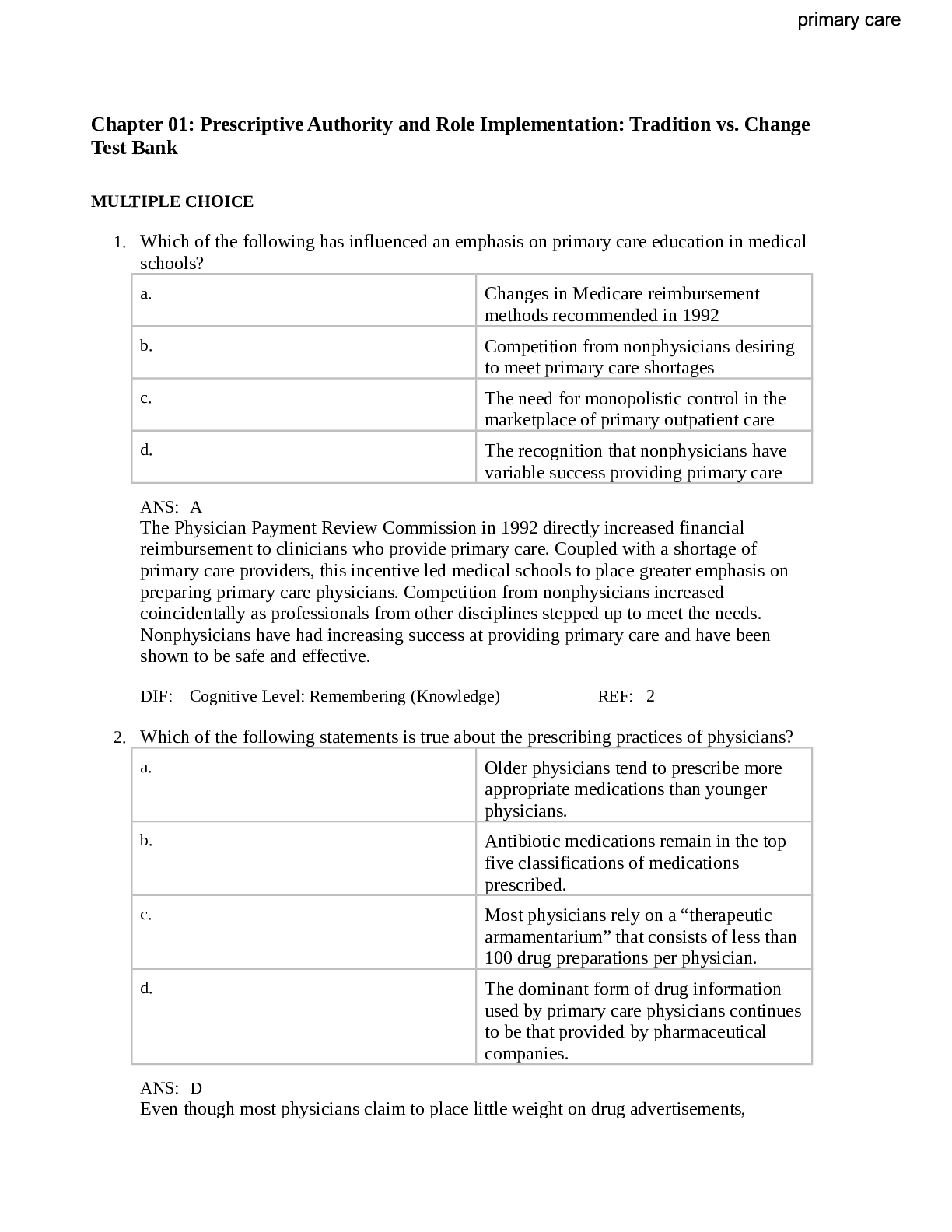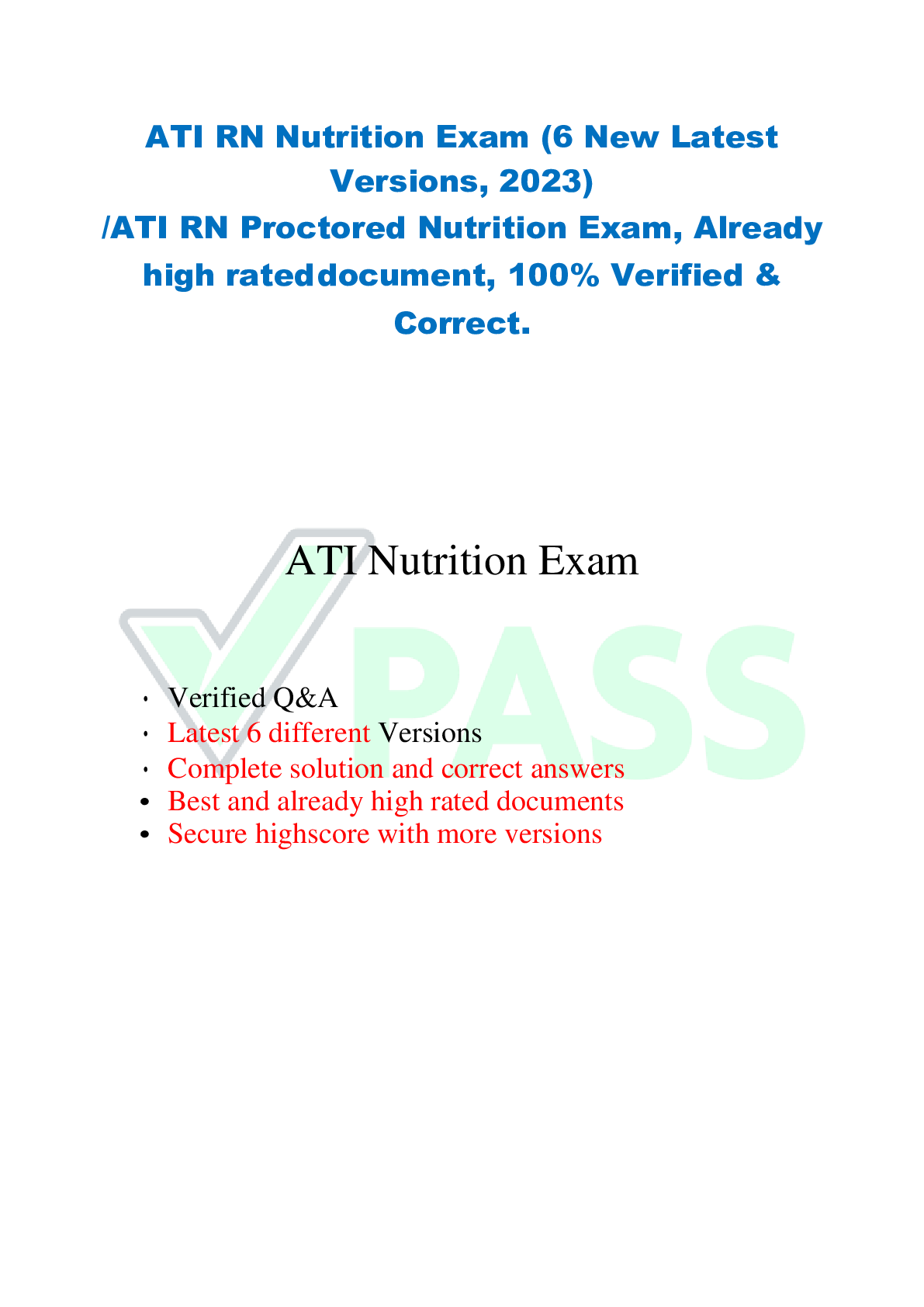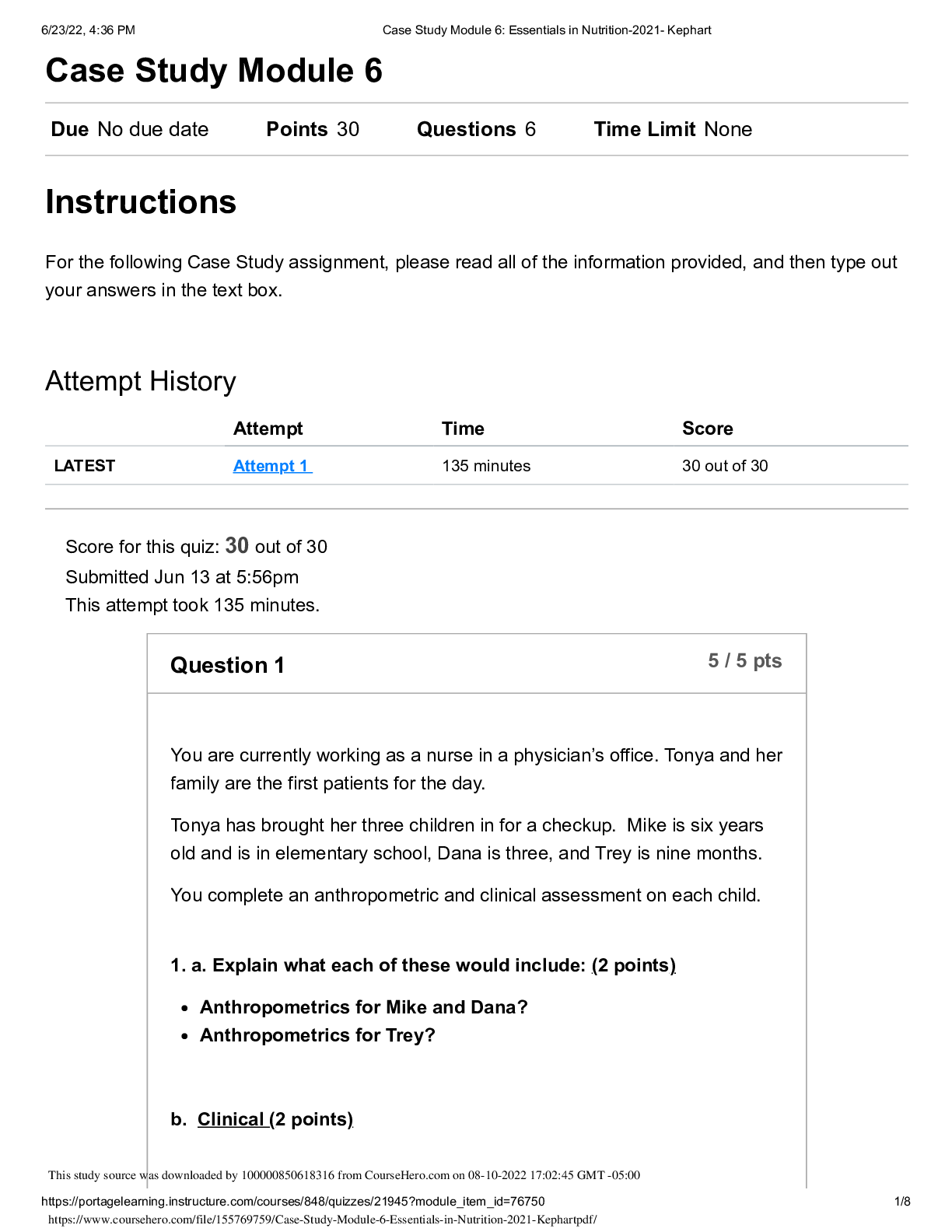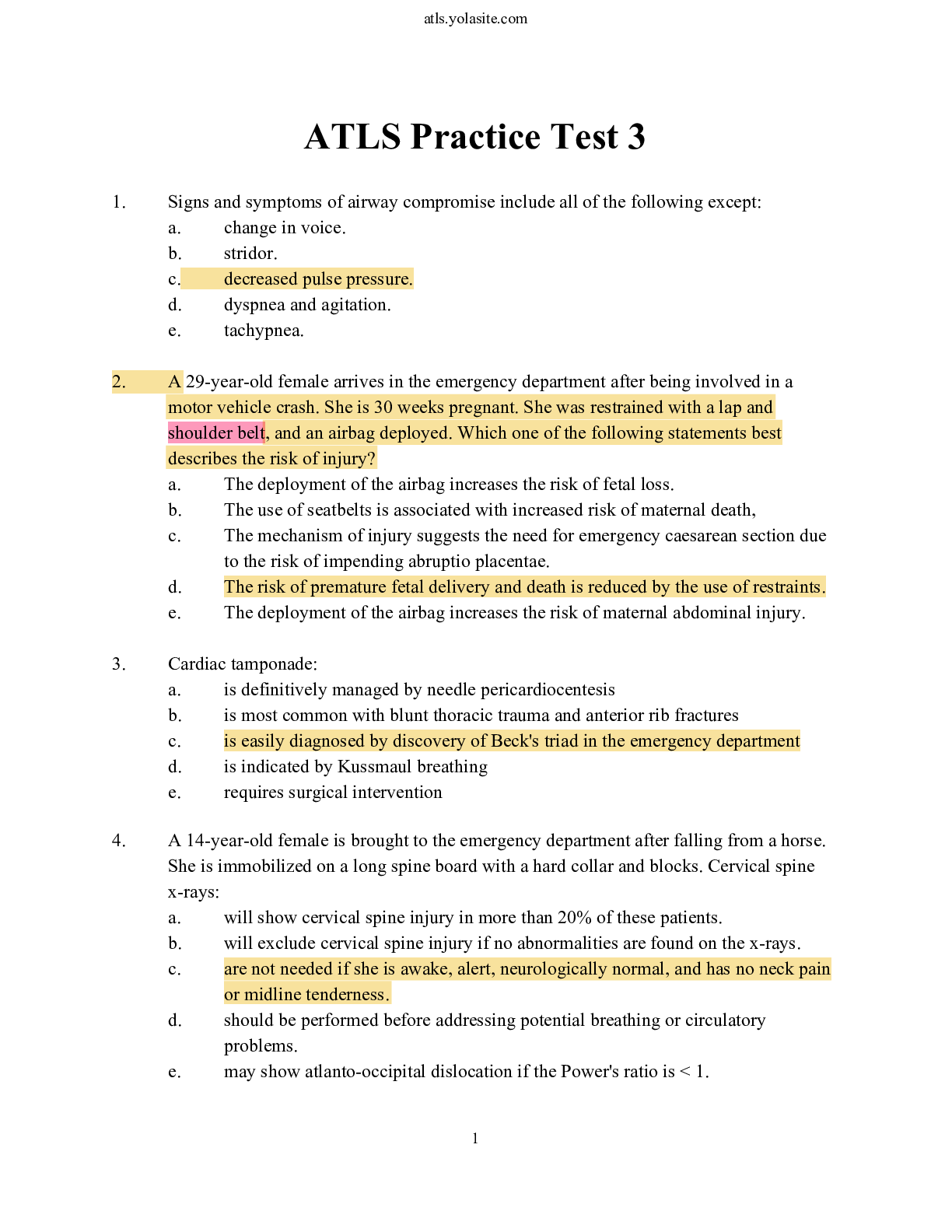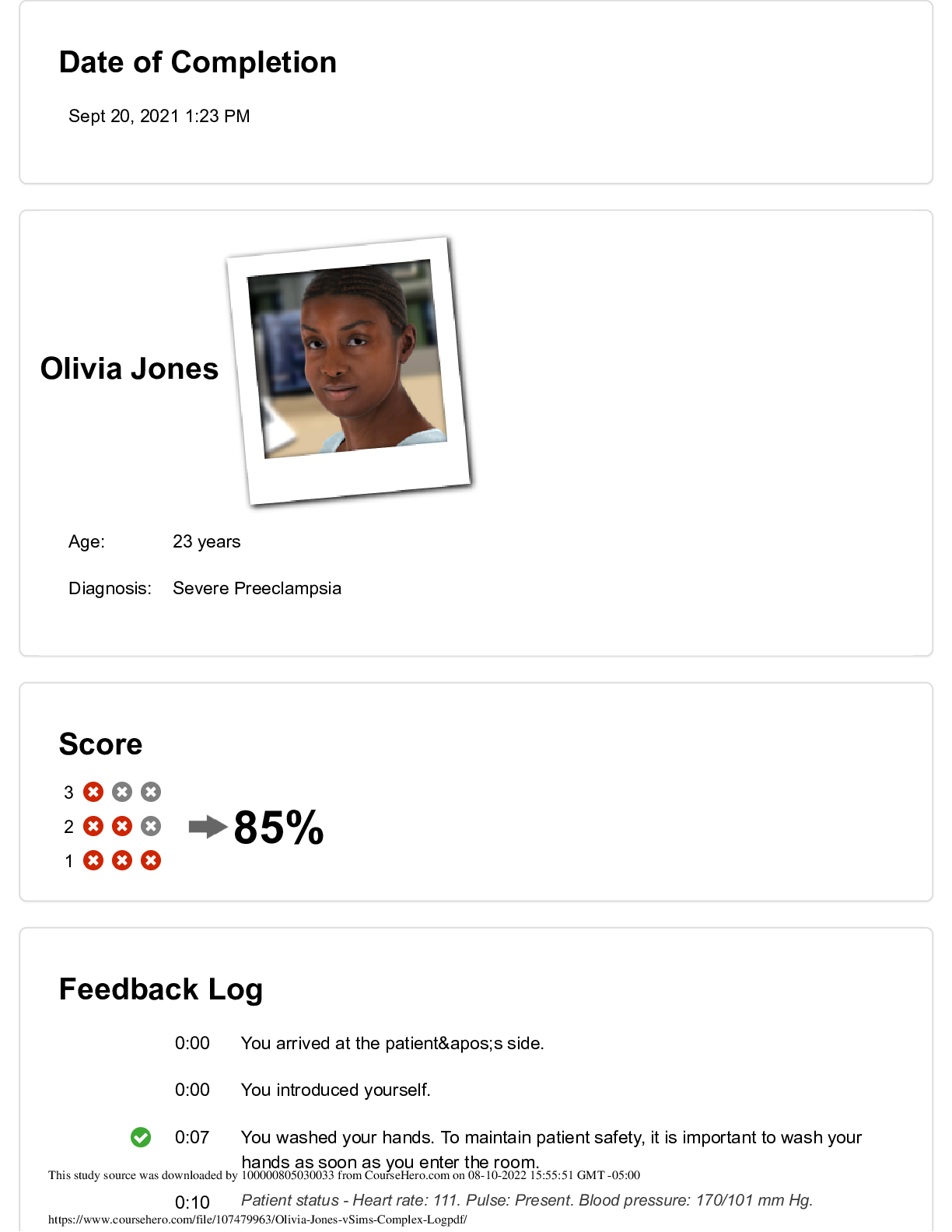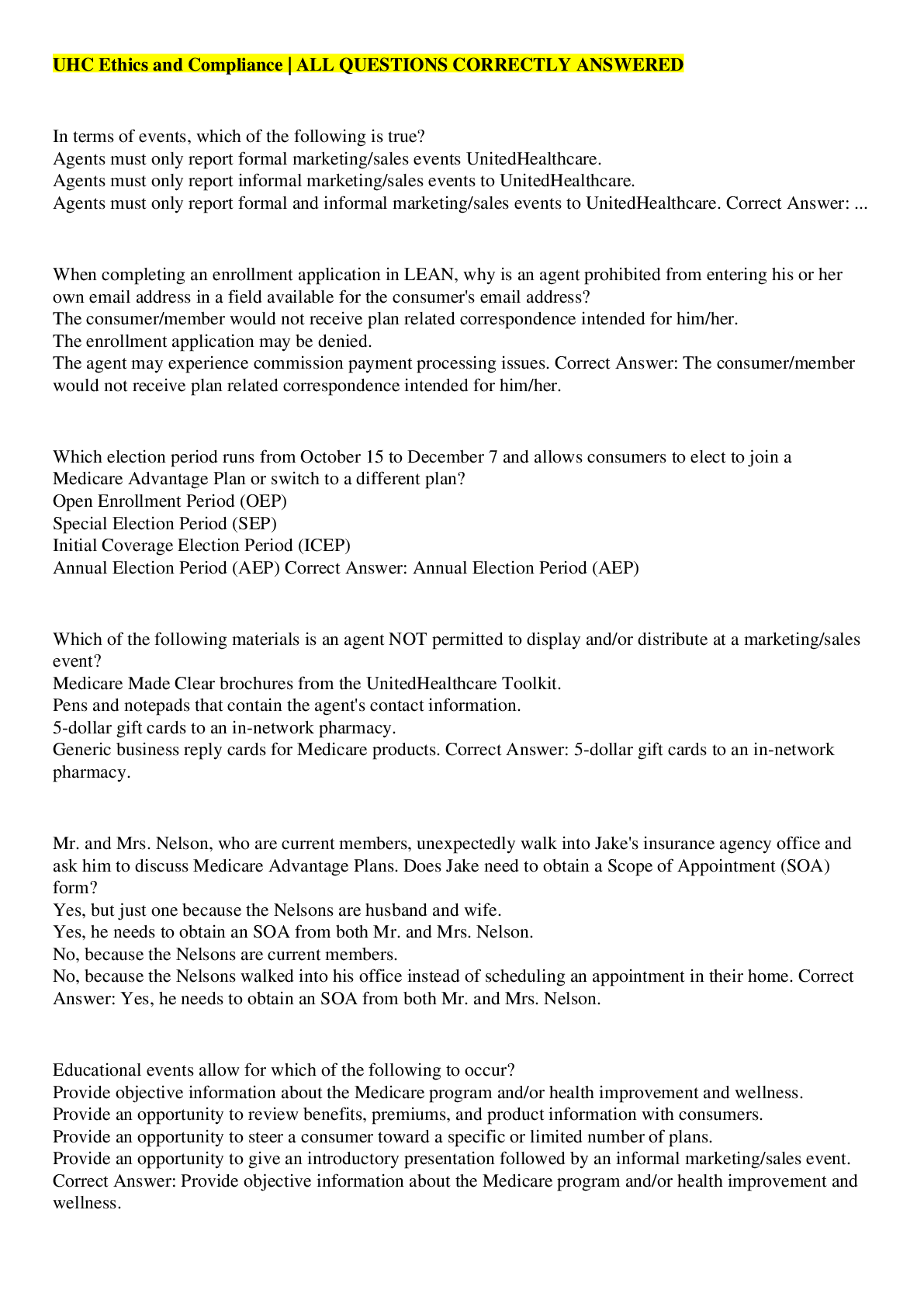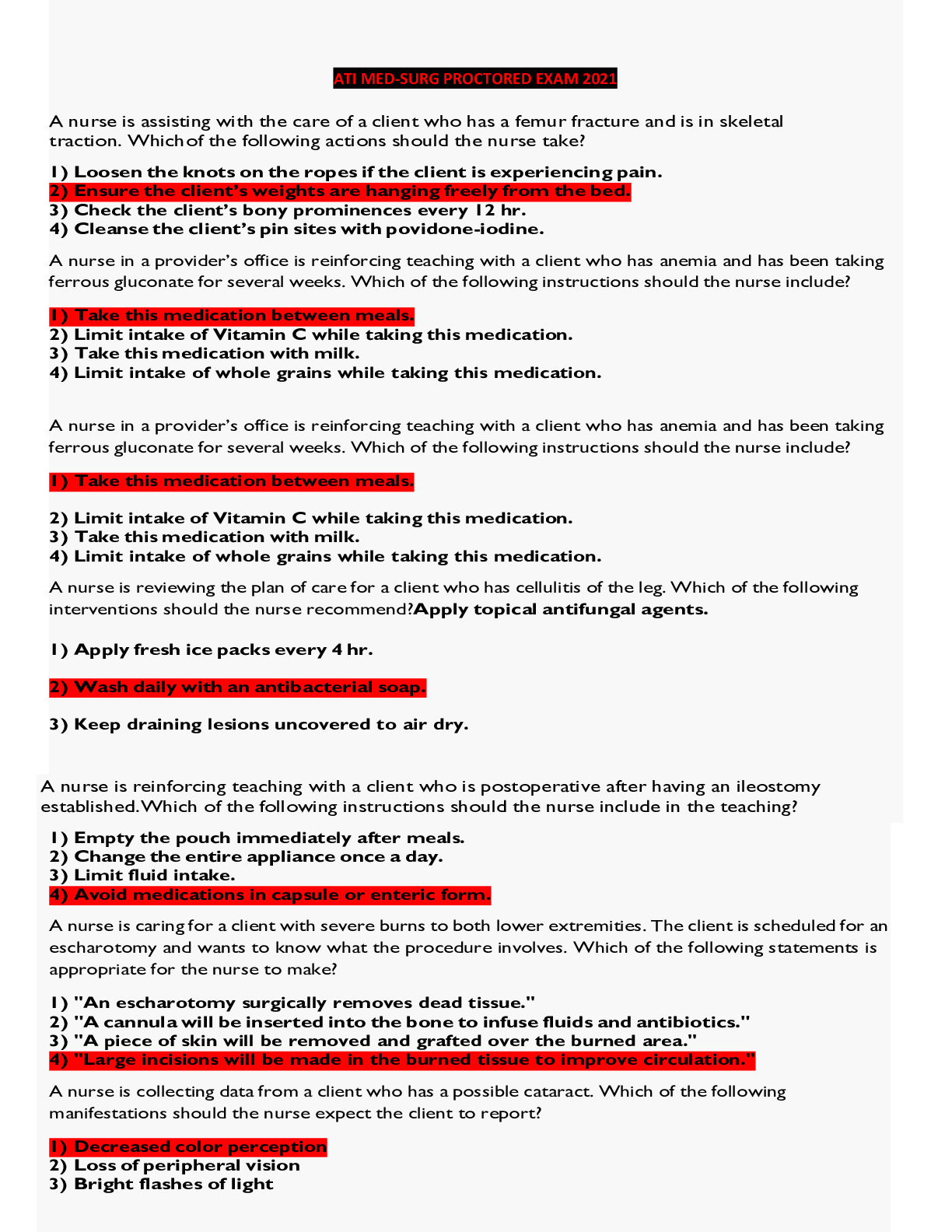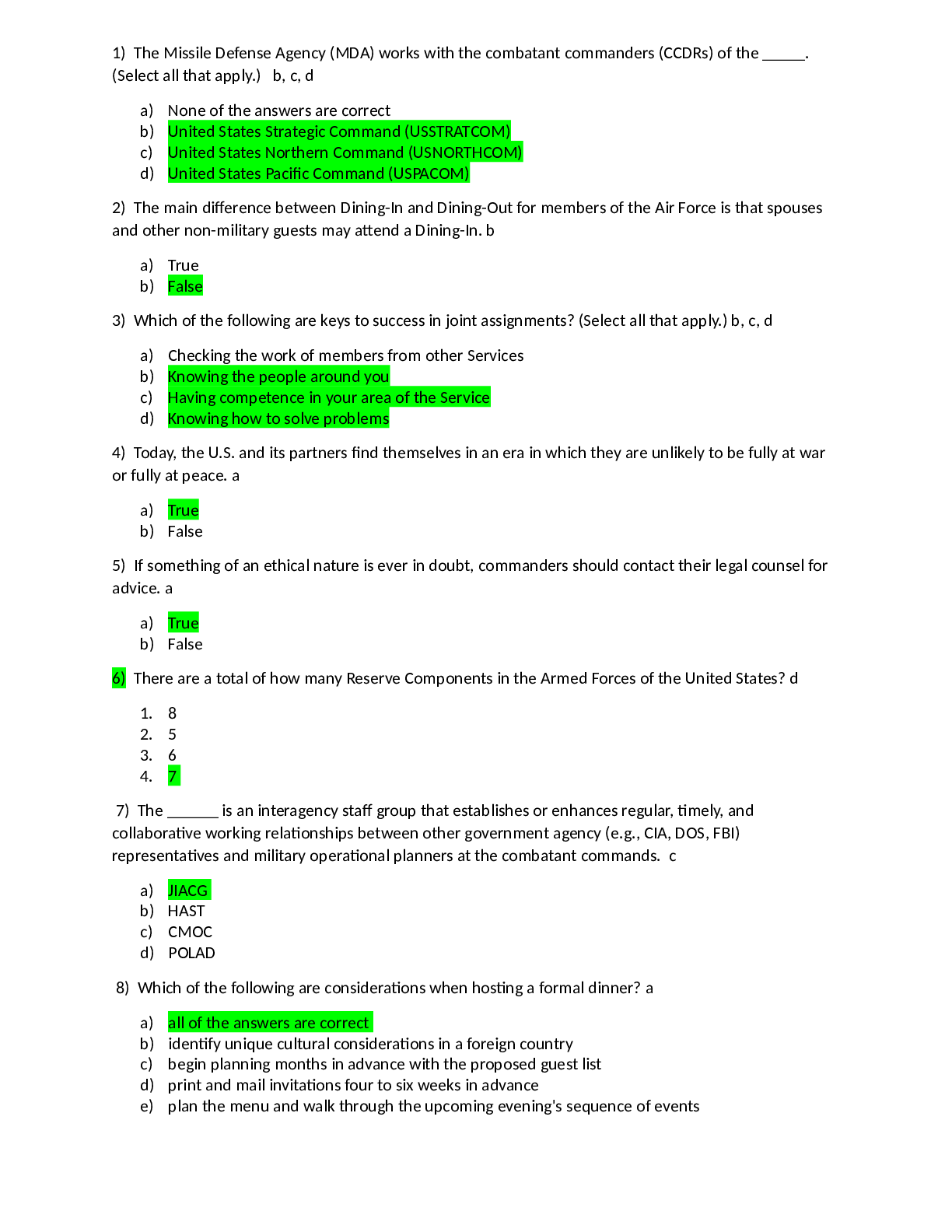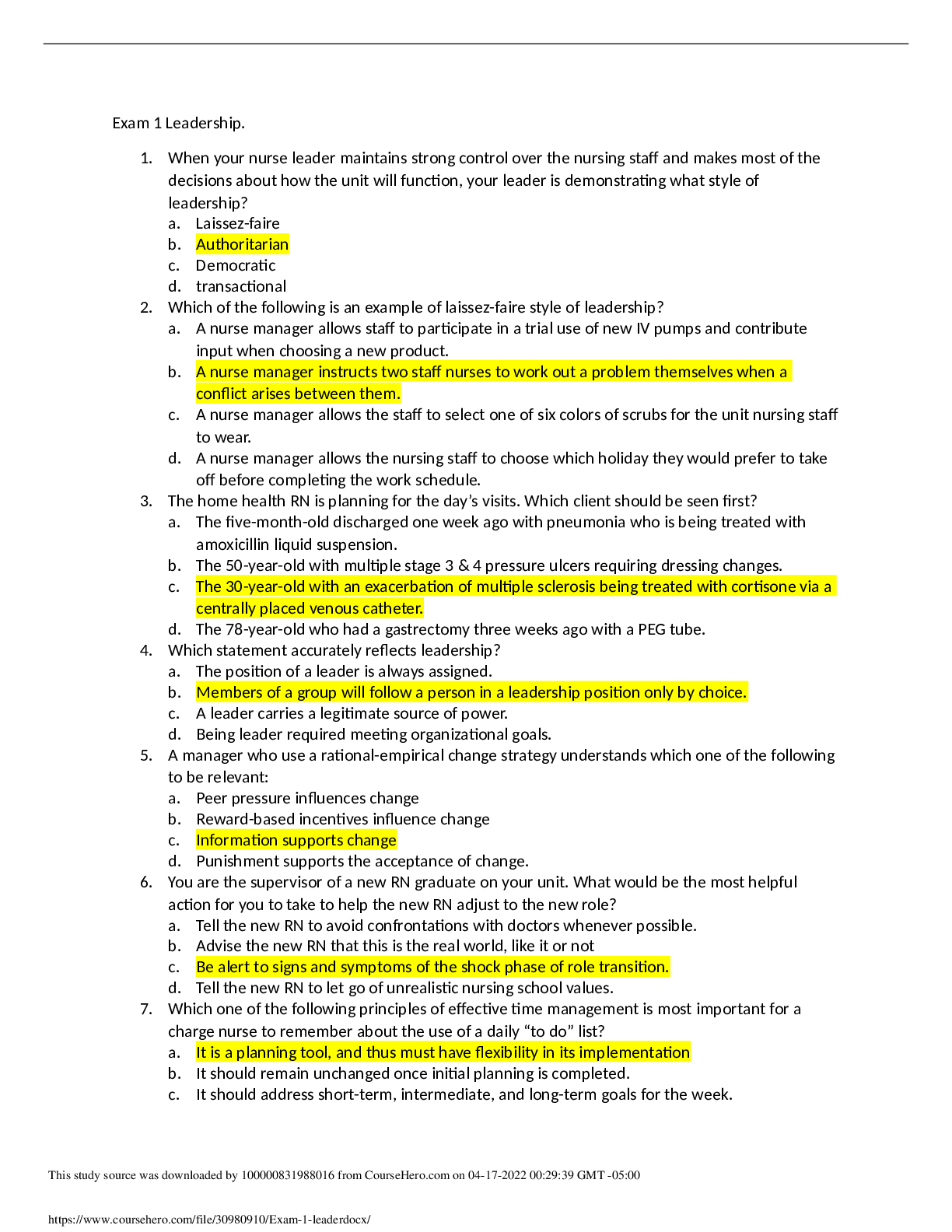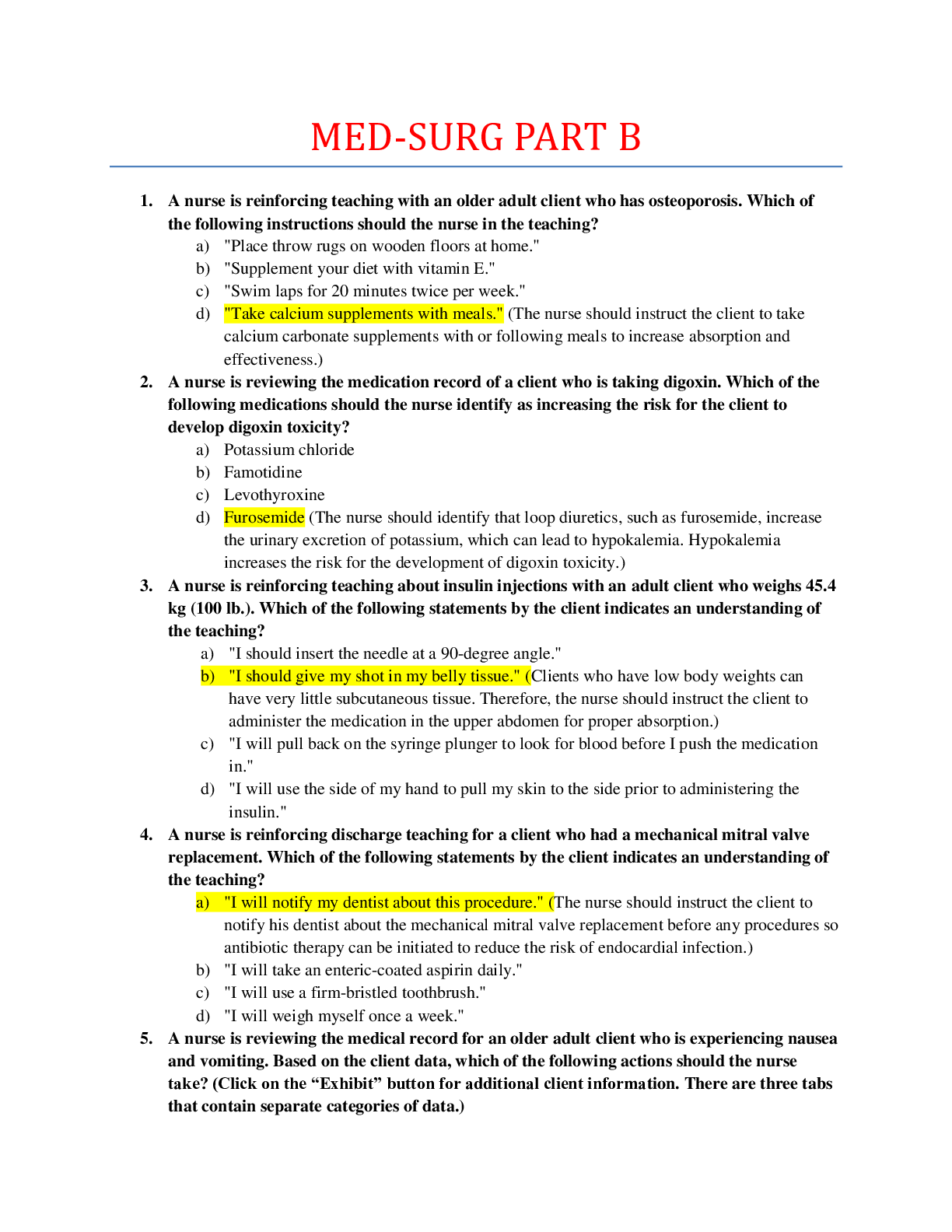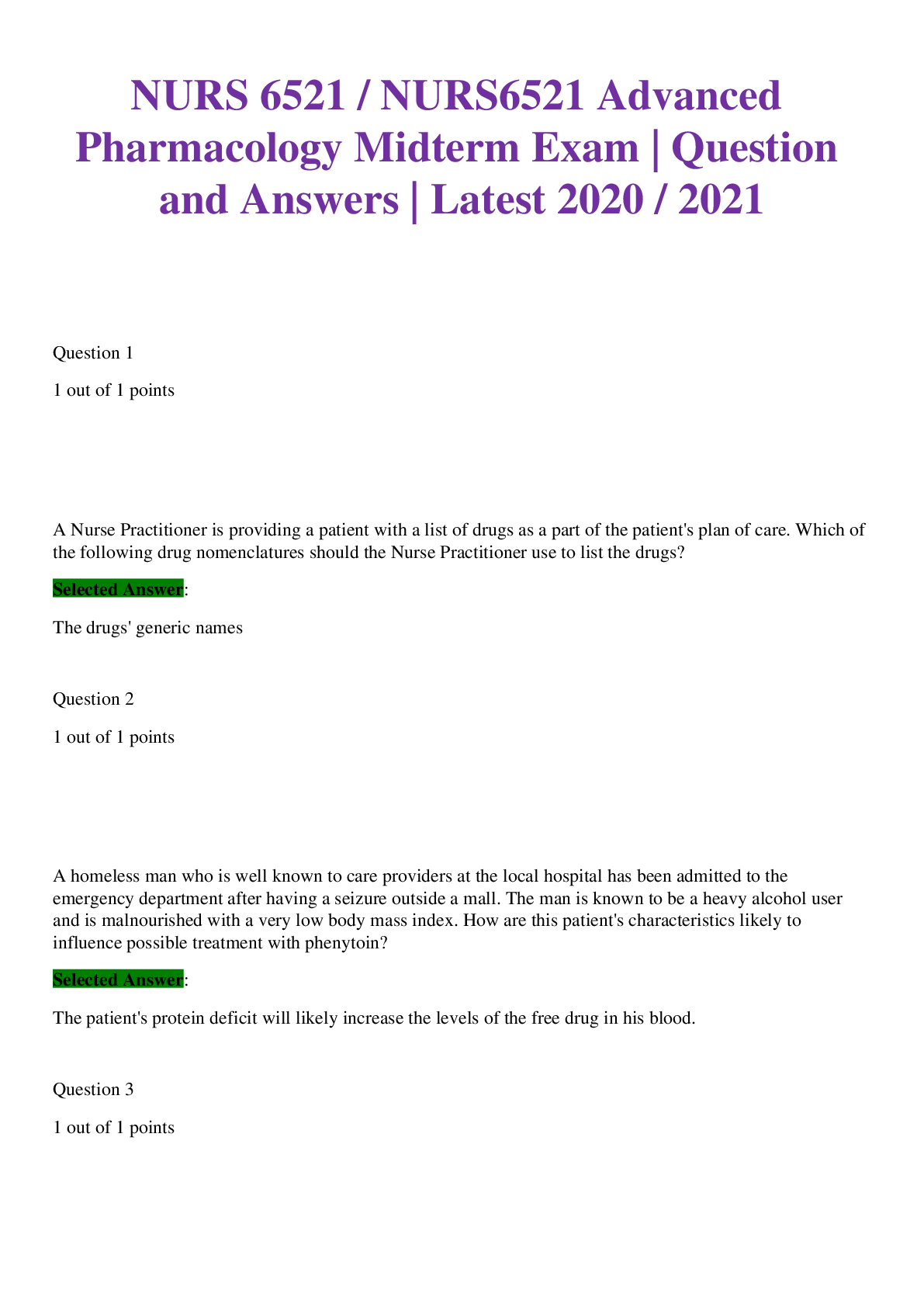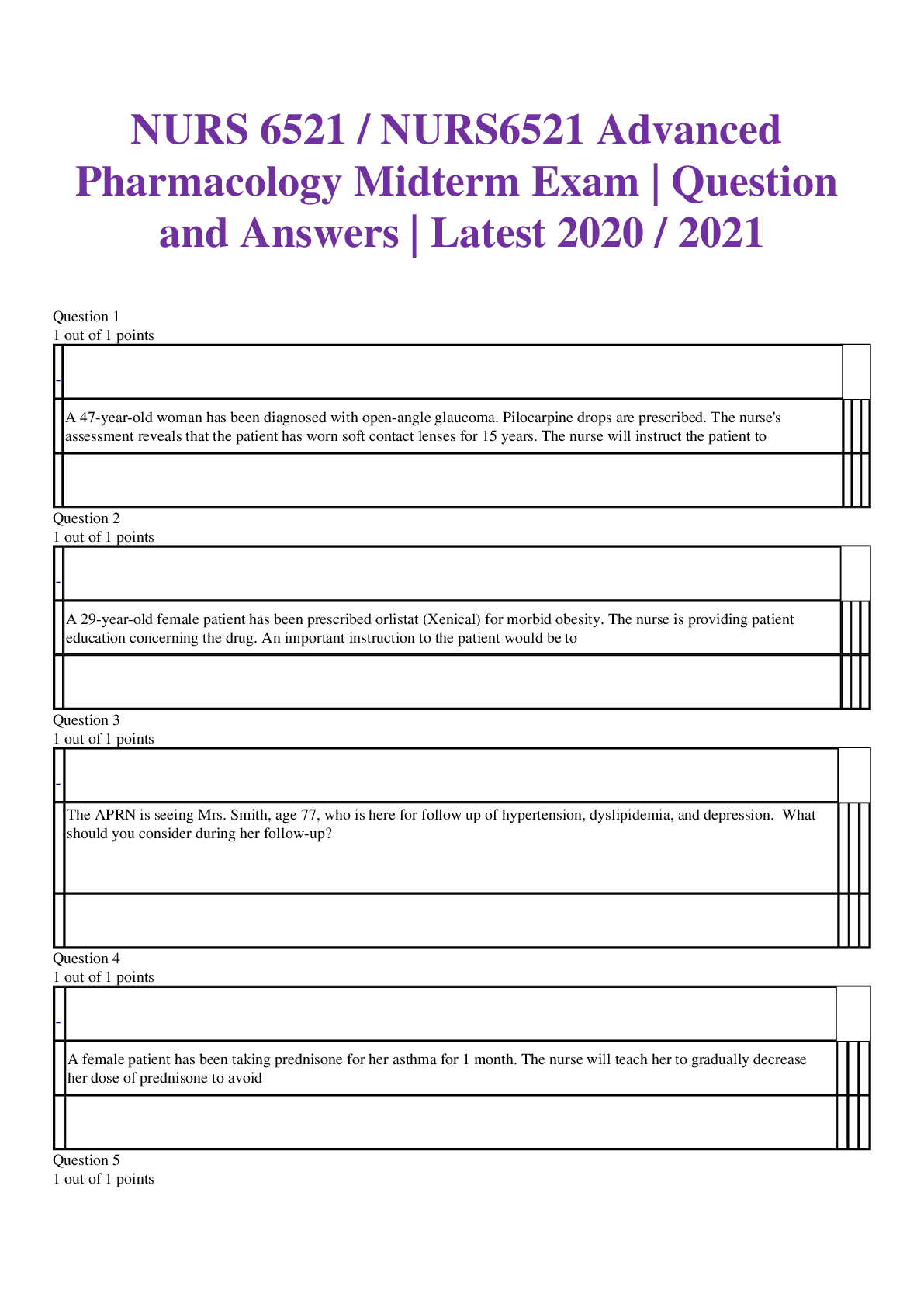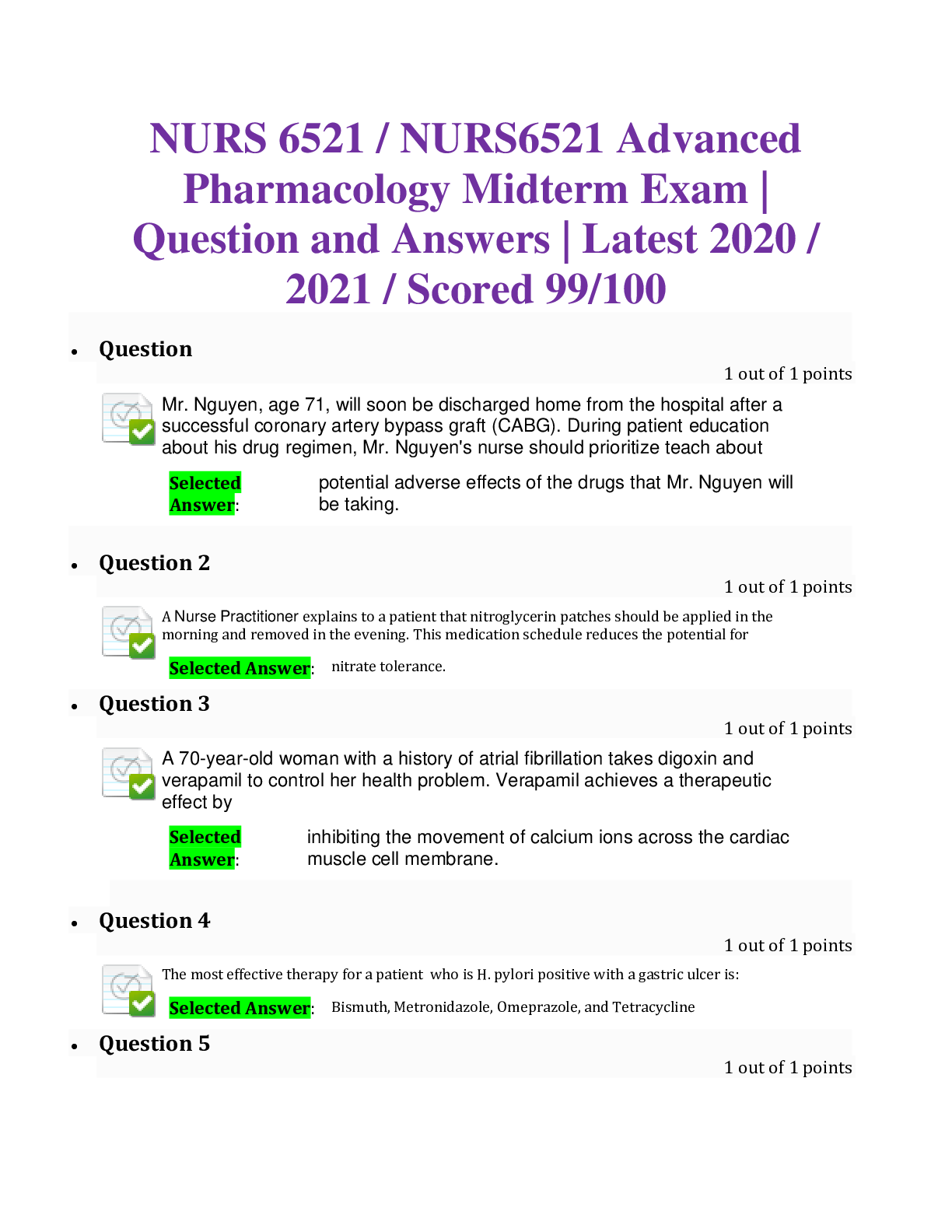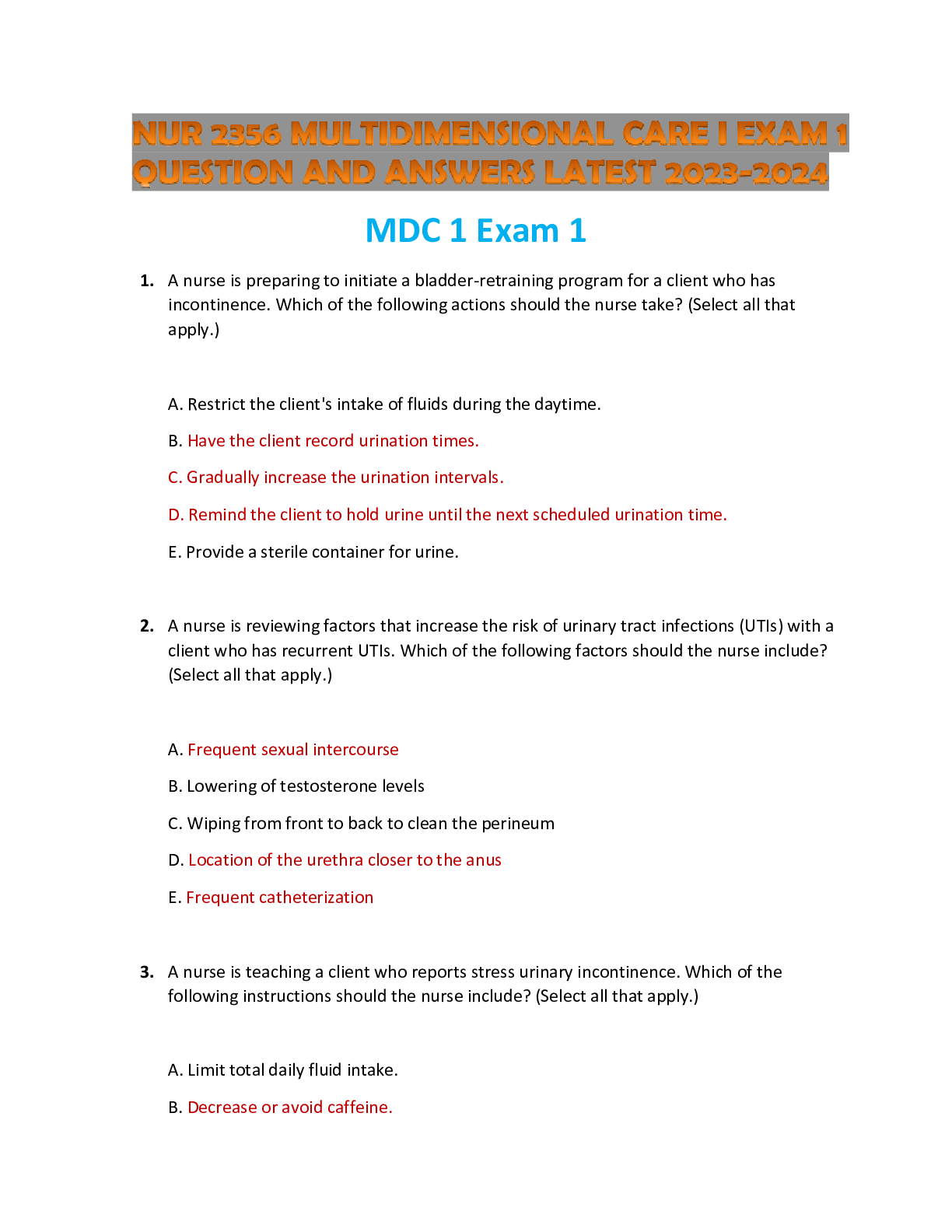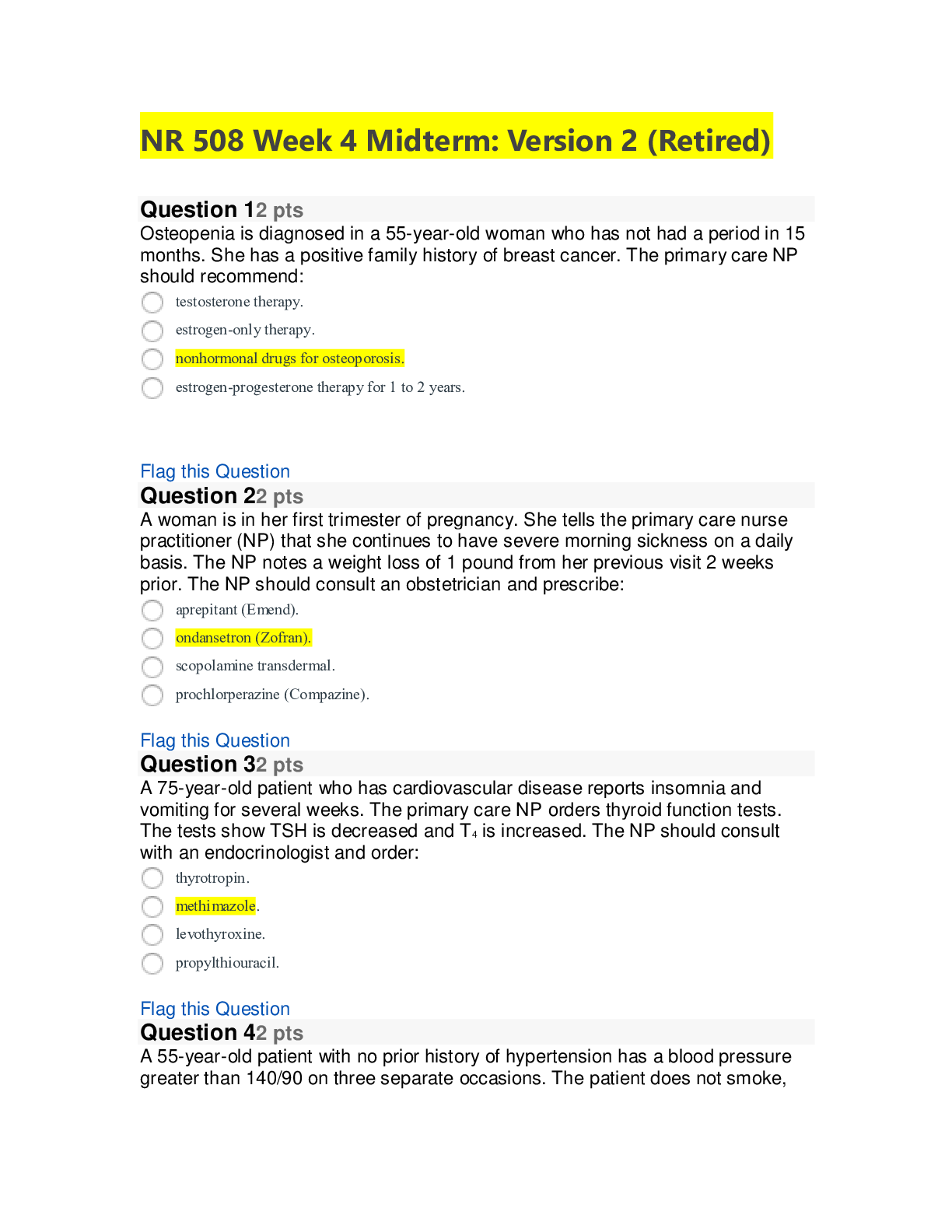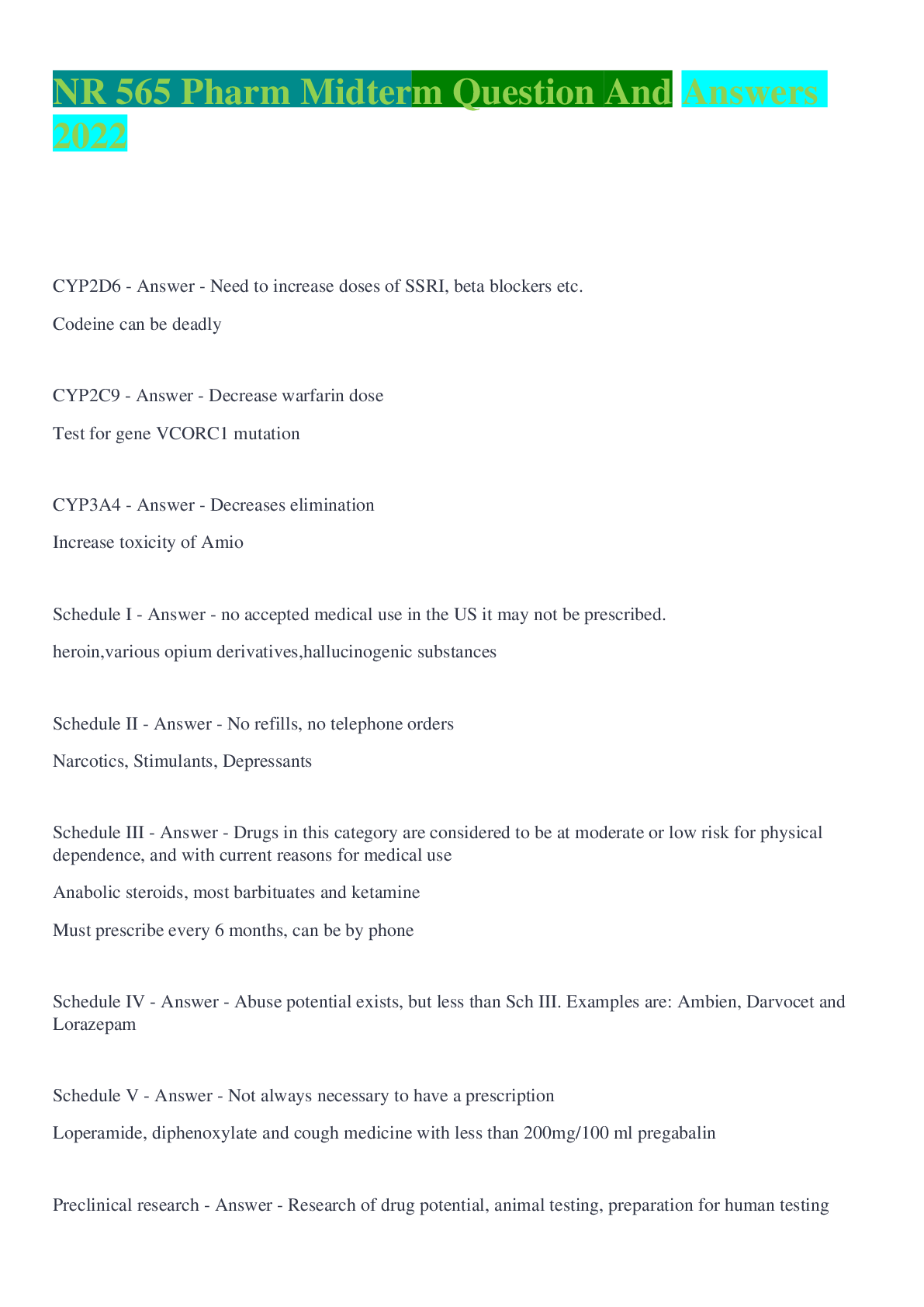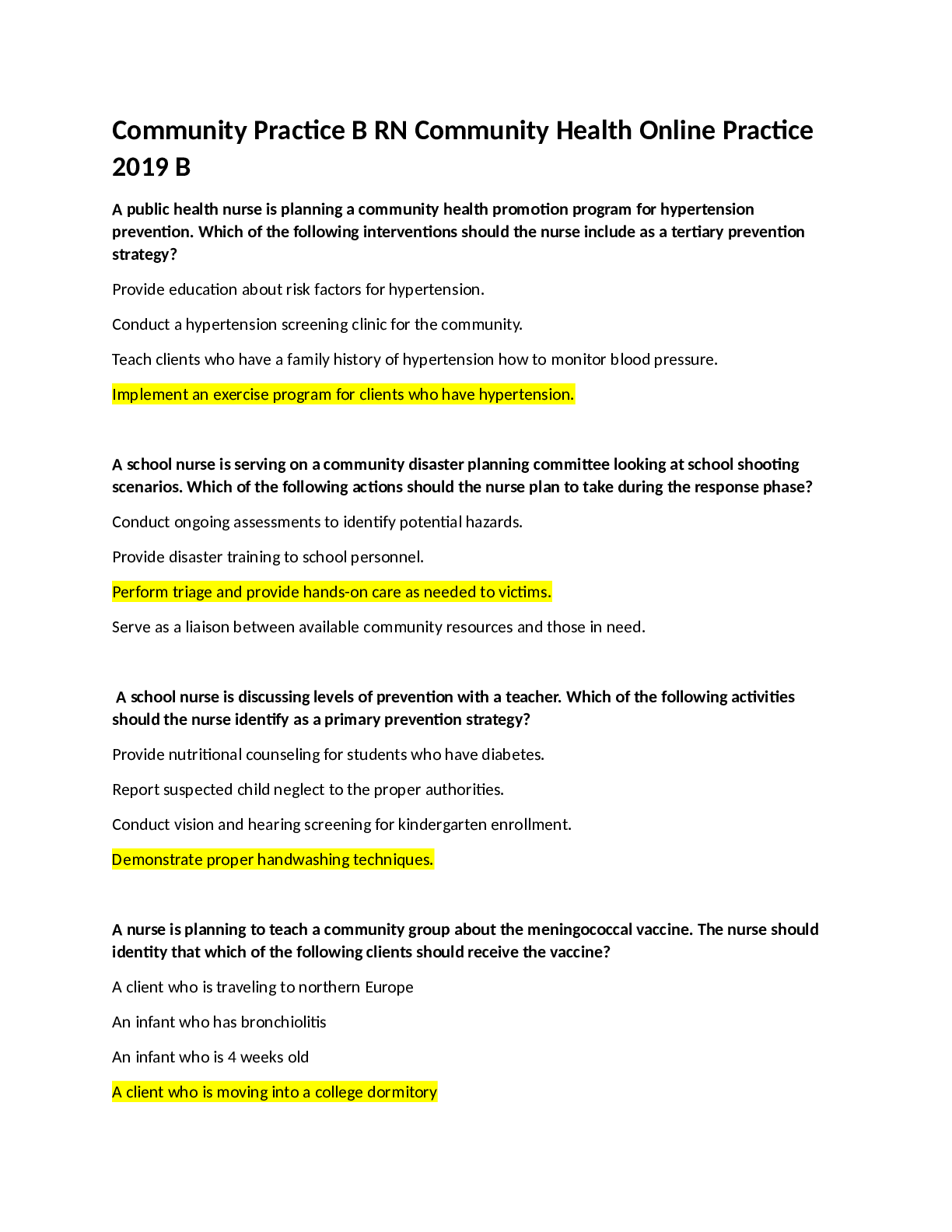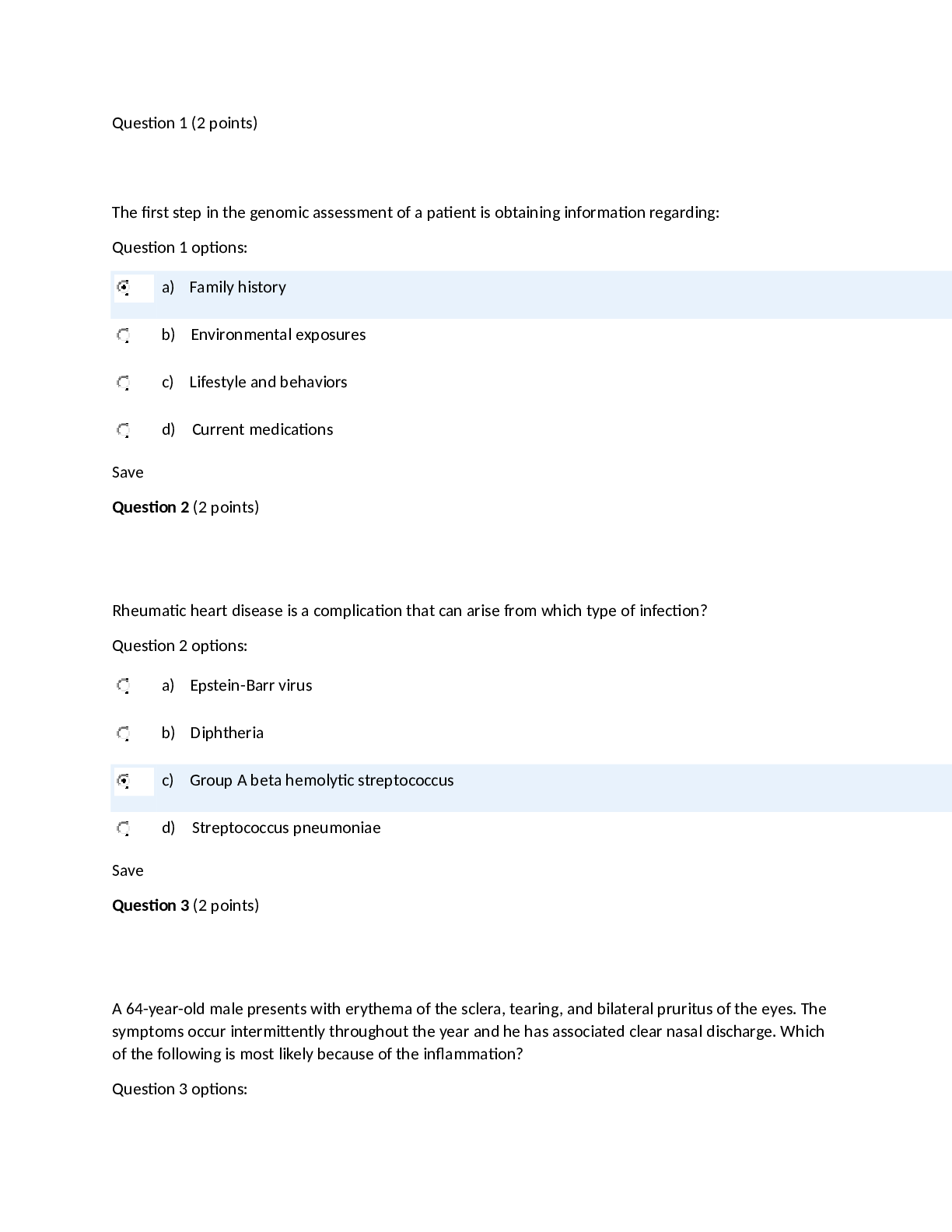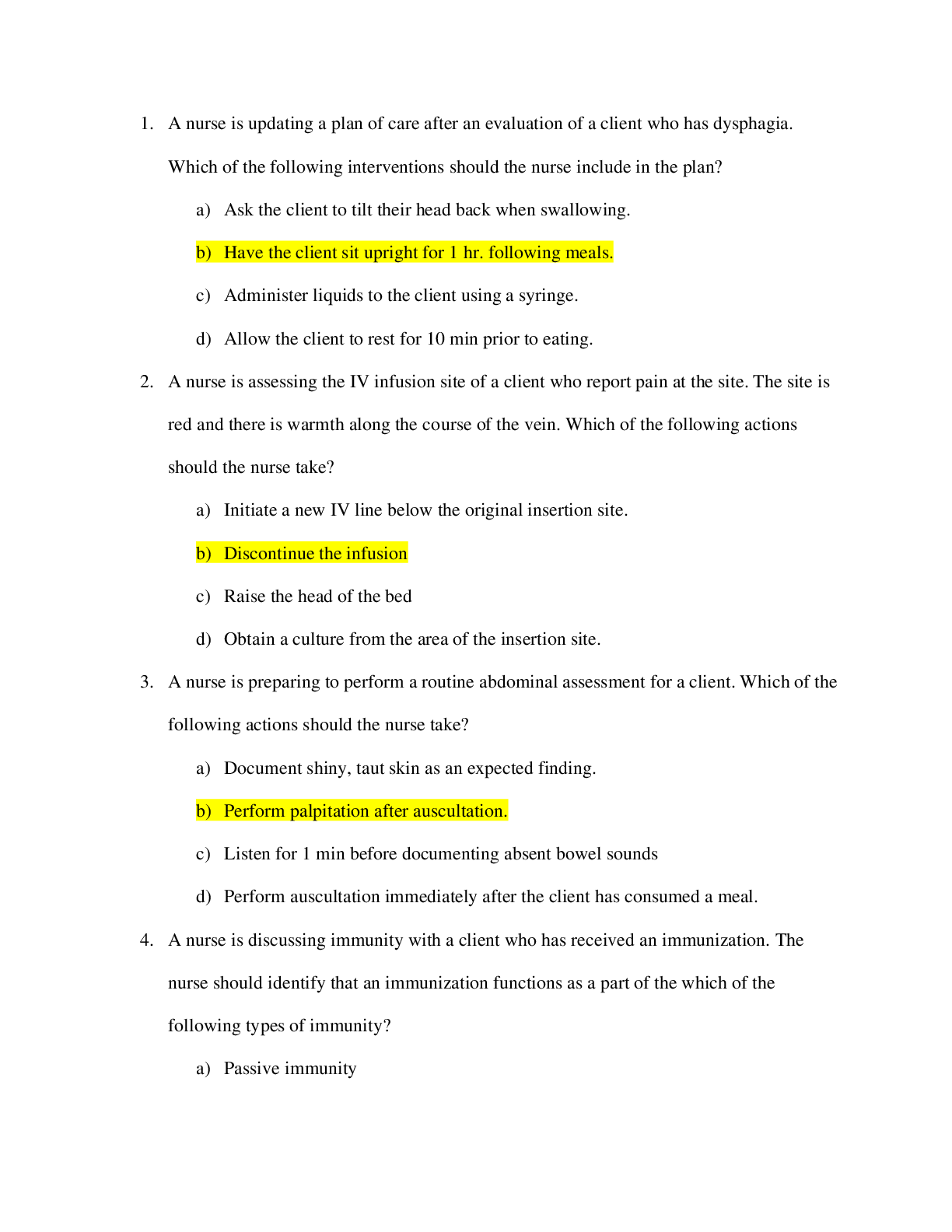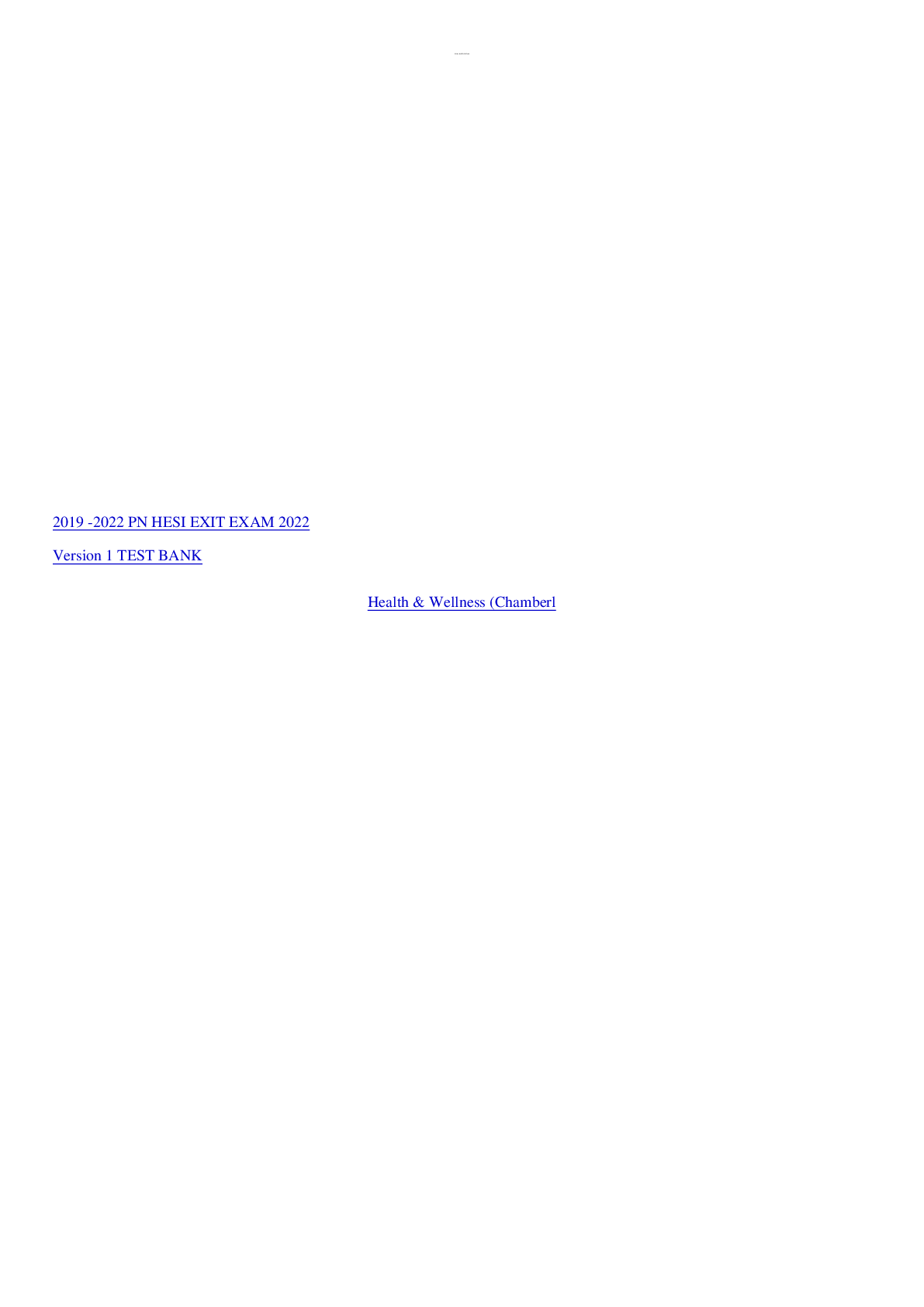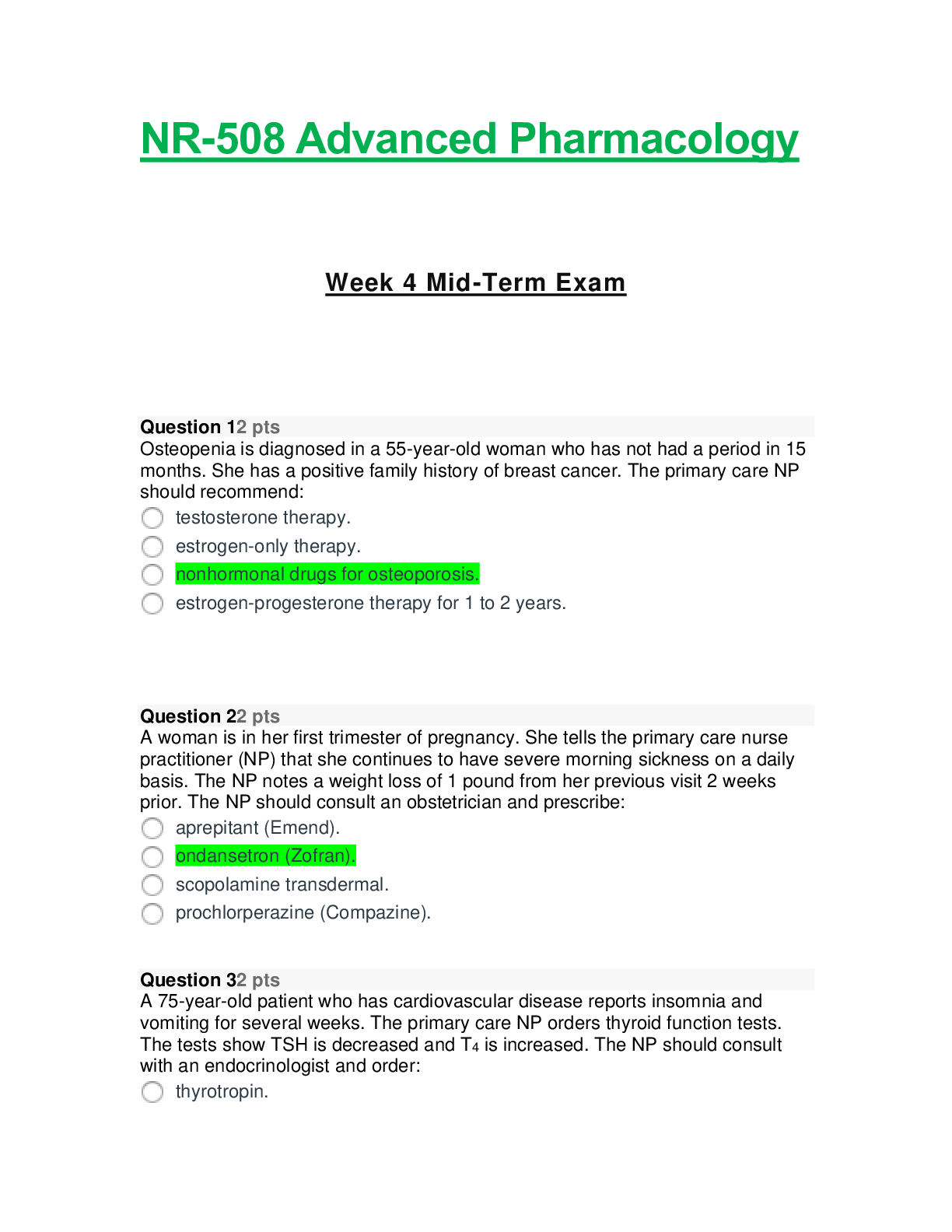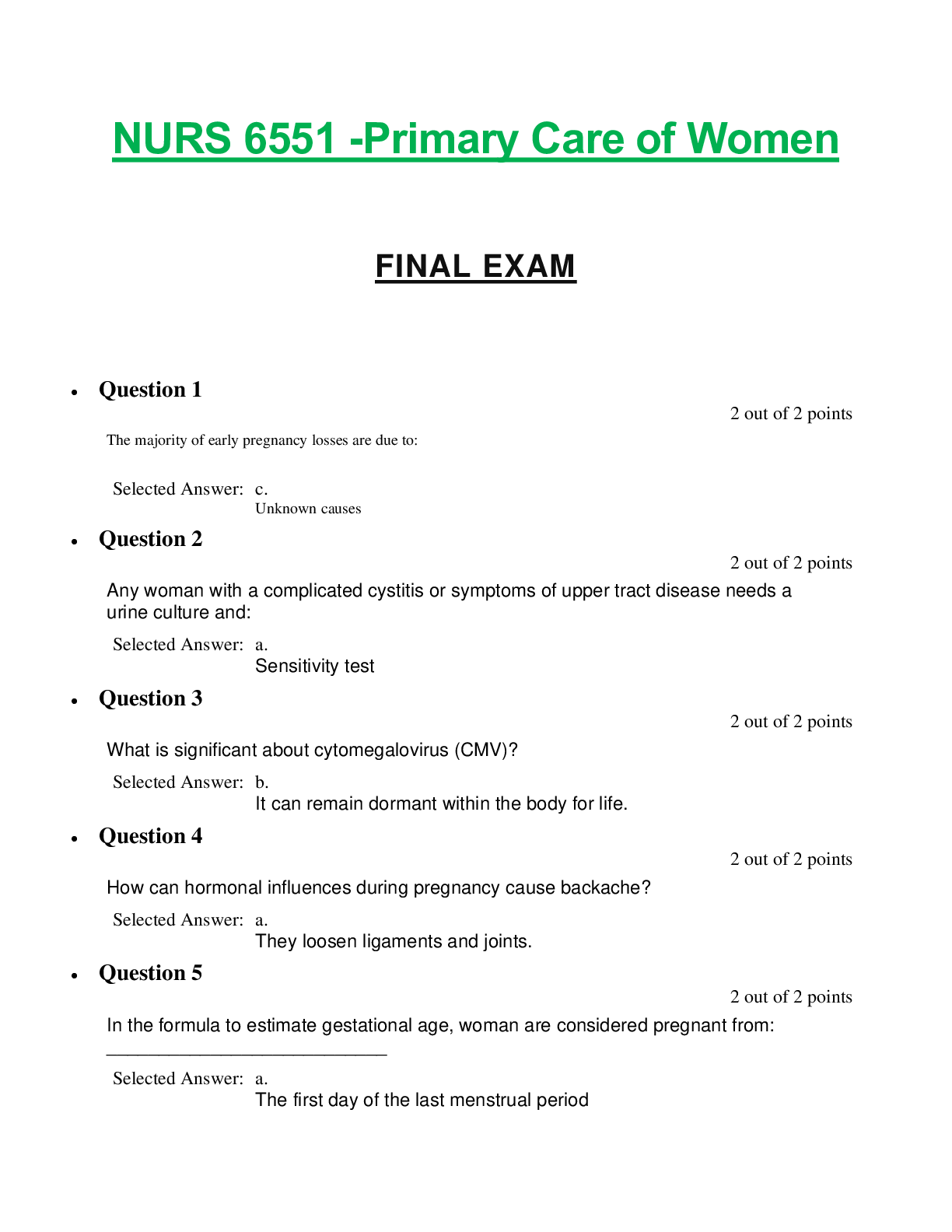*NURSING > EXAM > Maternal and Newborn Success A question and answers Review Applying Critical Thinking to Test Taking (All)
Maternal and Newborn Success A question and answers Review Applying Critical Thinking to Test Taking THIRD EDITION
Document Content and Description Below
1 Introduction 1 USE THIS BOOK AS ONE EDUCATIONAL STRATEGY 1 LEARN THE MATERIAL 2 READ YOUR ASSIGNMENTS 2 DISCUSS THE INFORMATION 2 ORGANIZE THE INFORMATION 2 Understand the Problem 2 Determine... the Significance of the Pathophysiology 3 Identify Signs and Symptoms 3 USE THE NURSING PROCESS 4 Assess 4 Formulate Nursing Diagnoses 4 Develop a Plan of Care 4 Implement the Care 6 Evaluate the Care 6 TYPES OF QUESTIONS 6 Multiple-Choice Questions 7 Fill-in-the-Blank Questions 7 Drag-and-Drop Questions 7 Multiple-Response Questions 8 Hot Spot Items 8 Items for Interpretation 9 KNOW HOW TO APPROACH EXAMINATION QUESTIONS 9 2 Sexuality, Fertility, and Genetics 11 KEYWORDS 11 QUESTIONS 12 Sexuality 12 Infertility 15 Genetics 21 ANSWERS AND RATIONALES 31 Sexuality 31 Infertility 34 Genetics 42 3 Women’s Health Issues 55 KEYWORDS 55 QUESTIONS 56 ANSWERS AND RATIONALES 71 4 Antepartum 93 KEYWORDS 93 QUESTIONS 94 ANSWERS AND RATIONALES 112 xi xii MATERNAL AND NEWBORN SUCCESS 5 Intrapartum 137 KEYWORDS 137 QUESTIONS 138 ANSWERS AND RATIONALES 153 6 Normal Newborn 175 KEYWORDS 175 QUESTIONS 176 ANSWERS AND RATIONALES 195 7 Normal Postpartum 223 KEYWORDS 223 QUESTIONS 224 ANSWERS AND RATIONALES 239 8 High-Risk Antepartum 259 KEYWORDS 259 QUESTIONS 260 ANSWERS AND RATIONALES 279 9 High-Risk Intrapartum 309 KEYWORDS 309 QUESTIONS 310 ANSWERS AND RATIONALES 329 10 High-Risk Newborn 357 KEYWORDS 357 QUESTIONS 358 ANSWERS AND RATIONALES 378 11 High-Risk Postpartum 413 KEYWORDS 413 QUESTIONS 414 ANSWERS AND RATIONALES 429 12 Comprehensive Examination 451 QUESTIONS 451 ANSWERS AND RATIONALES 467 References 489 Index 493 This book is part of a series published by F.A. Davis that is designed to assist student nurses in reviewing essential information and in taking examinations, particularly the NCLEX-RN® and certification examinations. The book focuses predominantly on childbearing—the antepartum, intrapartum, postpartum, and newborn periods—and, because of the childbear- ing focus, includes questions about fetal and neonatal development. In addition, because women are pregnant for such a short period of their lives, childbearing occurs within the context of the family, and embryonic and fetal development occur within the context of genetics, the text contains questions on those topics. Other subjects, including sexually transmitted illnesses, domestic violence, rape, and contraception, that affect women during the childbearing years—which make up about one-third of a woman’s life—are also included. As a result, this text is an excellent supplement for a number of nursing school courses, including parent-child nursing, fetal growth and development, basic genetics, family pro- cesses, and women’s health. To obtain the most from this book, the student is strongly encouraged to read the content related to the different topic areas and to study the material in a logical manner. Only if this is done will the book be valuable. Used as a supplement to foundational work, this book should be helpful in developing the skills needed to be successful on examinations in the relevant content areas. A discussion of the types of questions asked on examinations, of techniques for approach- ing test questions to identify what is being asked, and of how to select correct responses follows. USE THIS BOOK AS ONE EDUCATIONAL STRATEGY This book contains 11 subsequent chapters and is accompanied online with two compre- hensive examinations. This introductory chapter focuses on the types of questions included in the NCLEX-RN examination and on how to approach studying and preparing for an examination. Chapters 2 through 11 focus on topics related to maternity nursing, most specifically the antepartum, intrapartum, postpartum, and newborn periods. Each of these chapters contains practice questions that test a student’s knowledge along with answers and rationales with specific tips on how to approach answering the question. The reasons why a particular answer is correct and other answer options are incorrect are given. This infor- mation serves as a valuable learning tool for the student and helps to reinforce knowledge. Chapter 12 consists of a 100-question Comprehensive Examination with questions, answers, and rationales. 1 2 MATERNAL AND NEWBORN SUCCESS LEARN THE MATERIAL The first step to take before attempting to answer questions in this text—or on any examination—is to study and learn the relevant material. Learning does not mean simply reading textbooks and/or attending class. Learning is an active process that requires a number of complex skills, including reading, discussing, and organizing information. READ YOUR ASSIGNMENTS Students must first read their assignments. By far the best time to read the assigned material is before the class in which the information will be discussed. Then, if students have any questions about what was read, they can ask the instructor during class and clarify anything that is confusing. In addition, students will find discussions much more meaningful when they have a basic understanding of the material. DISCUSS THE INFORMATION During class time, material should be discussed with students rather than fed to them. Teachers have an obligation to provide stimulating and thought-provoking classes, but students also have an obligation to be prepared to engage in discussions upon entering the classroom. Although facts must be learned, nursing is not a fact-based profession. Nursing is an applied science. Nurses must use information. When a nurse enters a client’s room, the client rarely asks the nurse to define a term or to recite a fact. Rather, the client presents the nurse with a set of data that the nurse must interpret and act on. In other words, the nurse must think critically. Students, therefore, must discuss client-based information by asking “why” questions rather than simply learning facts by asking “what” questions. ORGANIZE THE INFORMATION While reading and discussing information, nursing students must begin to organize their knowledge. Nursing knowledge cannot be memorized. There is too much information to be memorized and, more importantly, memorization negatively affects the ability to use information. Nurses must be able to analyze data critically to determine priorities and actions. To think critically, nurses develop connections between and among elements of information. There are several steps for organizing basic information, including understanding the pathophysiology of a problem, determining its significance for a particular client, identify- ing signs and symptoms, and using the steps of the nursing process—assessment, formula- tion of a nursing diagnosis, development of a plan of care, implementation of that plan, and evaluation of the outcomes. An example—a woman with a diagnosis of placenta previa—is used in this chapter to illustrate the use of these interrelated steps to provide a pathway for organizing basic information. Whether studying for an examination or using skills in a specific clinical situation, it is often helpful to show graphically the relationships between and among various pieces of information, as is done below. Example: A client has placenta previa. The nurse must first understand the problem, determine its significance, and assess for signs and symptoms. Understand the Problem The first action is to understand (not memorize) the pathophysiology of the issue or problem. (Implicit is the prerequisite that the learner already fully understands the normal anatomy and physiology of pregnancy.) CHAPTER 1 INTRODUCTION 3 The placenta usually attaches to a highly vascular site in the decidua on the posterior wall of the uterus. Women who have compromised uterine vascularity—women who are multipa- rous, are smokers, have diabetes, or are carrying multiple gestations, for example—are at high risk for placenta previa. In this condition, the placenta, rather than attaching to the posterior portion of the uterine wall, attaches to an area immediately above or adjacent to the internal os of the uterus. Flow Chart—Understand the Problem. Determine the Significance of the Pathophysiology The second phase of the process is to determine the significance of the pathophysiology. Often the nurse is able to deduce the significance based on knowledge of normal anatomy and physiology. Because the placenta is the highly vascular organ that supplies oxygen and nutrients to the developing baby, it is essential to the well-being of the fetus. If the cervix were to dilate or be injured, the chorionic villi of the placenta would be disrupted. The mother would lose blood, and the baby’s oxygenation and nutrition would be critically affected, resulting in a life-threatening situation for both mother and fetus. Flow Chart—Determine the Significance of the Pathophysiology. Identify Signs and Symptoms Once the significance of the pathophysiology is deduced, it is essential to identify the signs and symptoms that are expected. In the mother, the nurse would expect to see bleeding with its associated changes in hema- tological signs (hematocrit and hemoglobin) and vital signs as well as anxiety. Because the placental bleeding will be unobstructed—that is, the blood will be able to escape easily via the vagina—the nurse would expect that the client would be in little to no pain and that the blood would be bright red. In addition, the nurse would expect the client’s hematological signs to be affected and the vital signs to change. However, because women have signifi- cantly elevated blood volumes during pregnancy, the pulse rate will elevate first, and the blood pressure will stay relatively stable. A drop in blood pressure is a late, and ominous, sign. In addition, the nurse would expect the mother to be anxious regarding her own and her baby’s well-being. In the fetus, if there were significant maternal blood loss and placental disturbance, the nurse would expect to see adverse changes in heart rate patterns. Late decelerations result from poor uteroplacental blood flow. Flow Chart—Identify Signs and Symptoms. 4 MATERNAL AND NEWBORN SUCCESS Once the problem and the data concerning it are understood, the significance deter- mined, and expected signs and symptoms identified, it is time for the student (and nurse) to turn to the nursing process. USE THE NURSING PROCESS The nursing process is foundational to nursing practice. To provide comprehensive care to their clients, nurses must understand and use each part of the nursing process—assessment, formulation of a nursing diagnosis, development of a plan of care, implementation of that plan, and evaluation of the outcomes. Assess Nurses gather a variety of information during the assessment phase of the nursing process. Some of the information is objective, or fact based. For example, a client’s hematocrit level and other blood values in the chart are facts that the nurse can use to determine a client’s needs. Nurses also must identify subjective data, or information as perceived through the eyes of the client. A client’s rating of pain is an excellent example of subjective information. Nurses must be aware of which data must be assessed because each and every client situa- tion is unique. In other words, nurses must be able to use the information taught in class and individualize it for each client interaction to determine which objective data must be accessed and which questions should be asked of the client. Once the information is obtained, the nurse analyzes it. (See example above.) Formulate Nursing Diagnoses After the nurse has analyzed the data, a diagnosis is made. Nurses are licensed to treat actual or potential health problems. Nursing diagnoses are statements of the health problems that the nurse, in collaboration with the client, has concluded are critical to the client’s well-being. The nurse now must develop the nursing diagnoses and prioritize them as they relate to the care of a client with placenta previa. Because a woman with placenta previa may begin to bleed, it is essential that the nurse develop two sets of diagnoses: one aimed at preventing complications—that is, “risk for” diagnoses—and one directed at the worst-case scenario— that is, if the client should start to bleed. The “risk for” placenta previa nursing diagnoses are: • Risk for maternal imbalanced fluid volume related to (r/t) hypovolemia secondary to exces- sive blood loss • Risk for impaired fetal gas exchange r/t decreased blood volume and maternal cardiovas- cular compromise • Maternal anxiety r/t concern for personal and fetal health The worst-case scenario (active bleeding) nursing diagnoses are: • Imbalanced maternal fluid volume r/t hypovolemia secondary to excessive blood loss • Impaired fetal gas exchange r/t decreased blood volume and maternal cardiovascular compromise • Maternal anxiety r/t concern for personal and fetal health Develop a Plan of Care The nurse develops a plan of care, including goals of care, expected client outcomes, and interventions necessary to achieve the goals and outcomes. The nurse determines what he or she wishes to achieve in relation to each of the diagnoses and how to go about meeting those goals. CHAPTER 1 INTRODUCTION 5 One very important part of this process is the development of the priorities of care. The nurse must determine which diagnoses are the most important and, consequently, which actions are the most important. For example, a client’s physical well-being must take pre- cedence over emotional well-being. It is essential that the nurse consider the client’s priori- ties and the goals and orders of the client’s primary healthcare provider. The nurse caring for the client with placenta previa develops a plan of care based on the diagnoses listed above. Because the physical conditions must take precedence, the nurse prioritizes the plan with the physical needs first. The client’s emotional needs will then be considered. The plan of care to meet the “at risk” nursing diagnoses is shown in Box 1-1, and a plan for the worst-case scenario—active bleeding—is shown in Box 1-2. BOX 1-1 PLAN OF CARE FOR CLIENT WITH PLACENTA PREVIA AT RISK FOR BLEEDING BOX 1-2 PLAN OF CARE FOR PATIENT WITH PLACENTA PREVIA WHO IS BLEEDING continued 6 MATERNAL AND NEWBORN SUCCESS continued BOX 1-2 PLAN OF CARE FOR PATIENT WITH PLACENTA PREVIA WHO IS BLEEDING Implement the Care Once the plan is established, the nurse implements it. The plan may include direct client care by the nurse and/or care that is coordinated by the nurse but performed by other practitioners. If assessment data change during implementation, the nurse must reanalyze the data, change diagnoses, and reprioritize care. One very important aspect of nursing care is that it be evidence based. Nurses are inde- pendent practitioners. They are mandated to provide safe, therapeutic care that has a sci- entific basis. Nurses, therefore, must engage in lifelong learning. It is essential that nurses realize that much of the information in textbooks is outdated before the text was even published. To provide evidence-based care, nurses must keep their knowledge current by accessing information from reliable sources on the Internet, in professional journals, and at pro [Show More]
Last updated: 1 year ago
Preview 1 out of 522 pages
Instant download

Instant download
Reviews( 0 )
Document information
Connected school, study & course
About the document
Uploaded On
Jul 27, 2022
Number of pages
522
Written in
Additional information
This document has been written for:
Uploaded
Jul 27, 2022
Downloads
0
Views
45

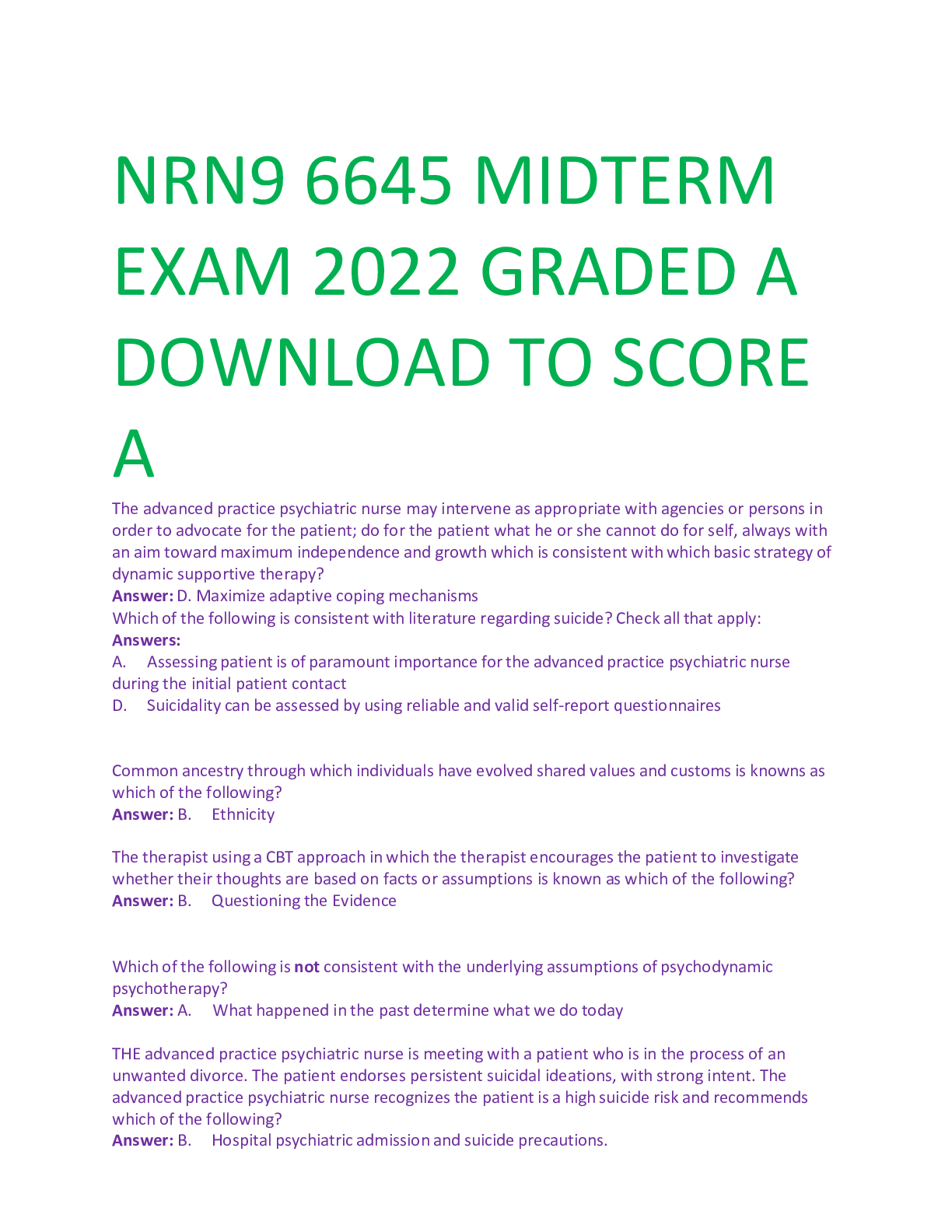
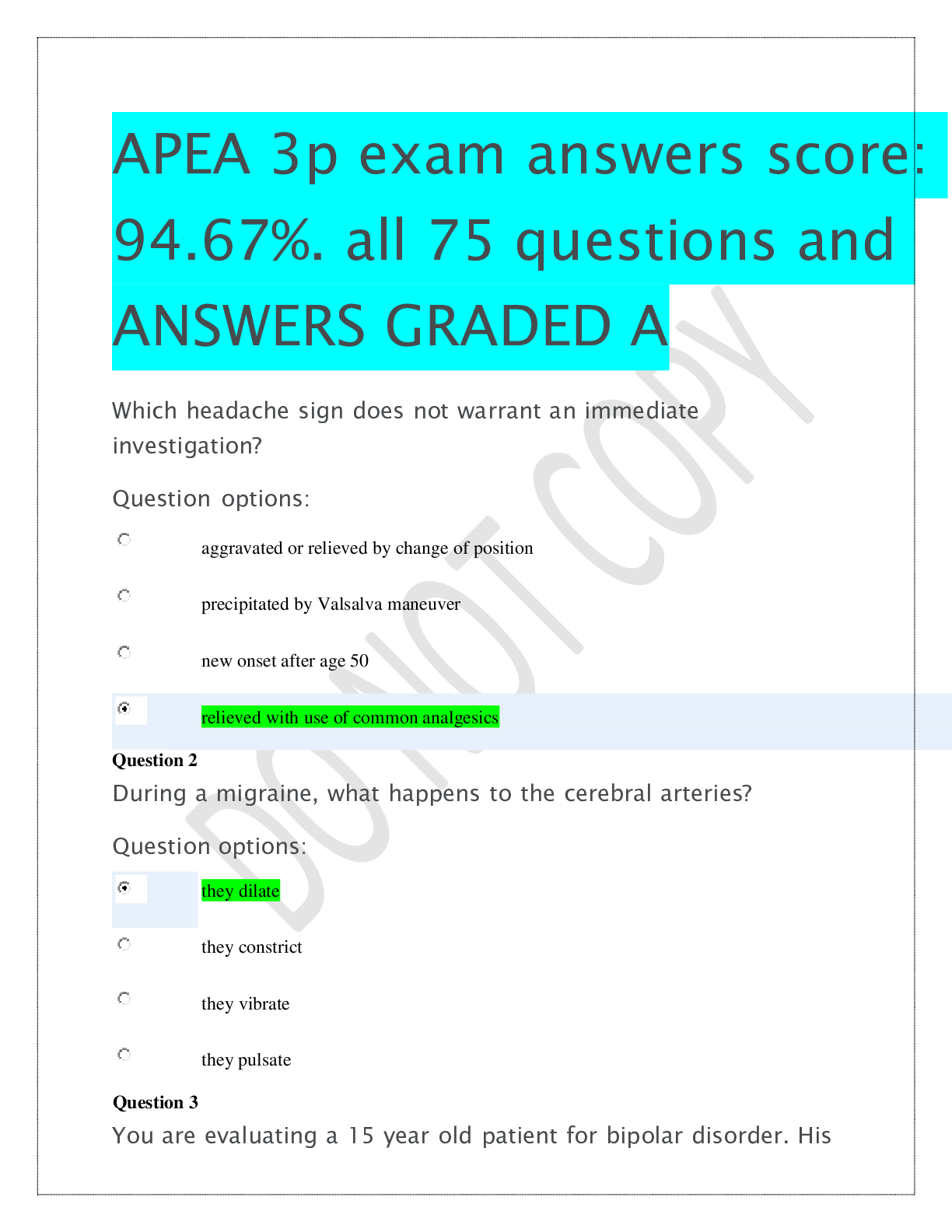

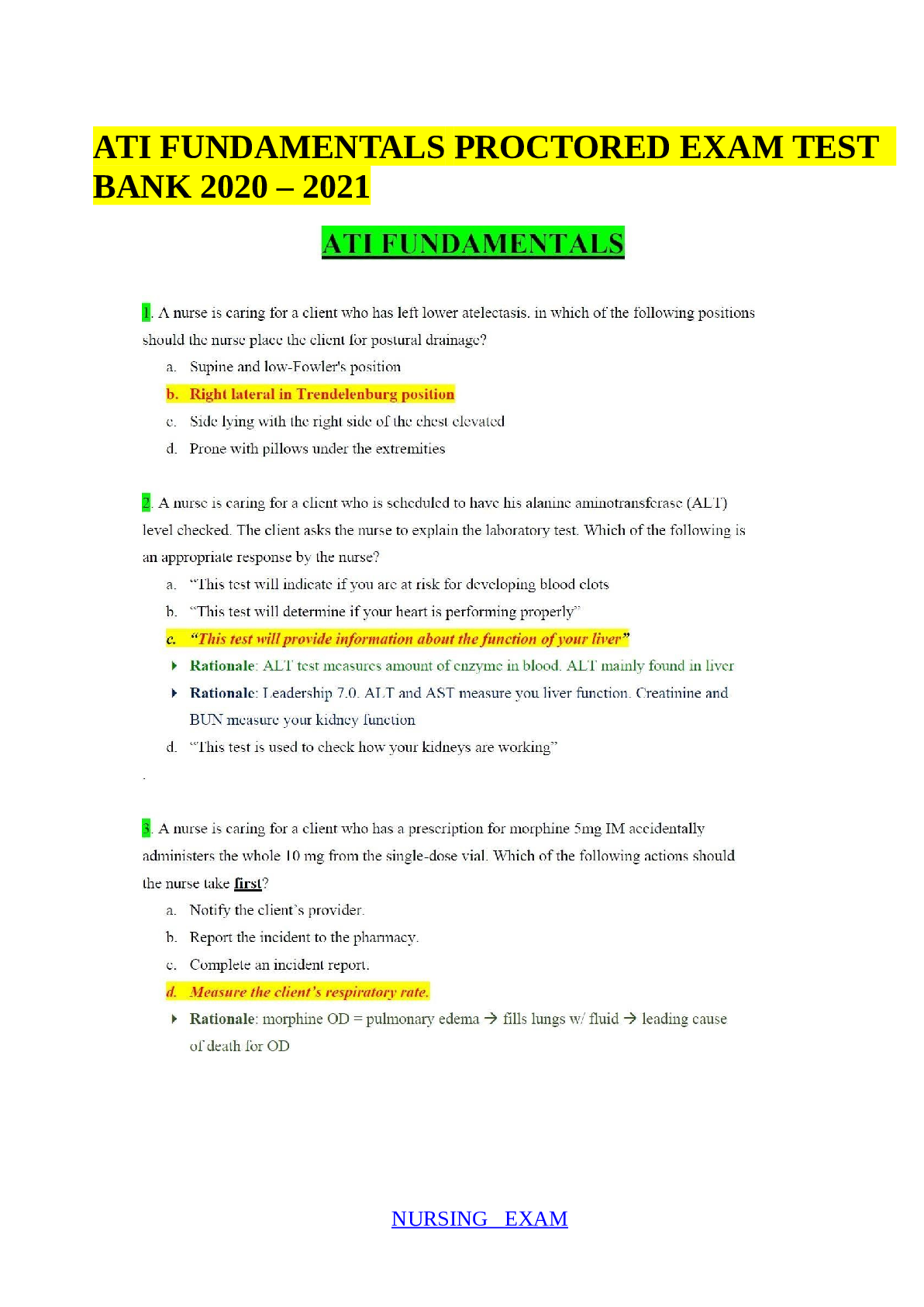
.png)
.png)

